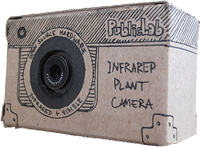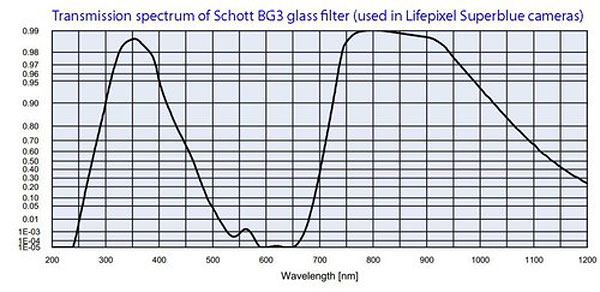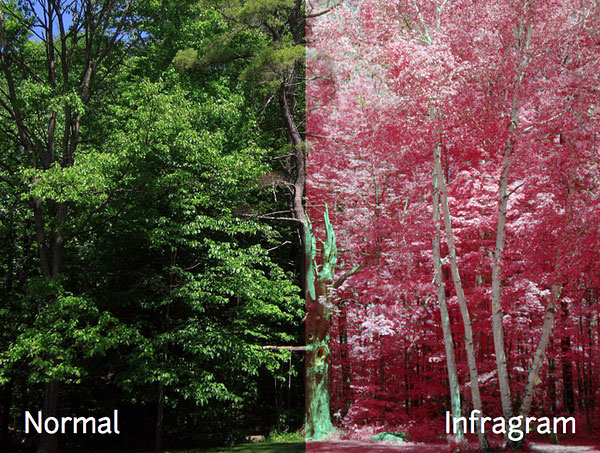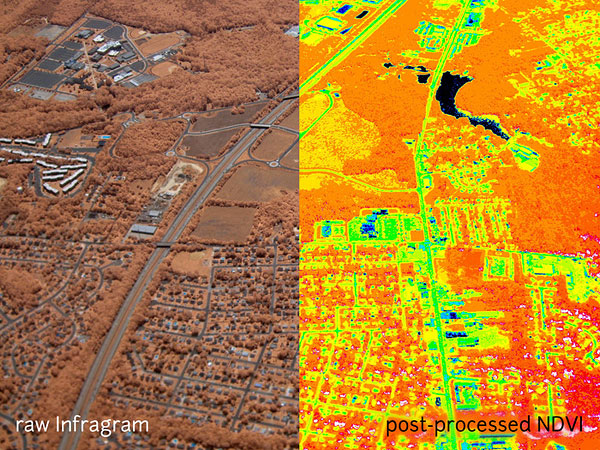Give yourself a green shutter finger with this foliage-friendly photo project
posted Thursday, May 30, 2013 at 7:48 PM EDT

Do you count horticulture alongside photography as favorite pursuits? If so, you might be interested to know that you can now combine the two, thanks to a new Kickstarter project from the Massachusetts-based Public Laboratory for Open Technology and Science. Chances are that you're already aware infrared photography fans sometimes have the IR cut filter removed from their camera, allowing them to shoot IR photos -- but did you know that almost the same technique can be used to monitor the health of everything from household plants to crops?
That, in a nutshell, is what the new Infragram photography project is doing, but instead of applying an infrared pass filter to the front of the newly defiltered camera's lens as IR photographers would, the folks at PLOTS are instead using a LifePixel Super Blue filter. This filter, which PLOTS suggests is likely a Schott BG3, allows plenty of blue and infrared light to pass, but squashes wavelengths in between. A little green still makes it through, but red light in particular is squashed to almost nothing. That allows the red channel of the modified digital camera to capture only the infrared signal, turning your RGB camera into an IrGB camera.
Once your photo is captured, the image can be processed to create what's known as a Normalized Difference Vegetation Index image -- essentially, the same thing that satellites from the likes of NASA create to monitor vegetation globally. Areas of healthy growth stand out clearly from those with poor growth, or no growth at all. And as a gardener or farmer armed with that information, you can get to work on figuring out the underlying cause of the problem, knowing precisely which area is most affected.

Of course, you're not going to want to use your everyday camera for something like this. Cameras include infrared cut filters for a reason: Infrared light might not be visible to your eye, but it's very visible to your camera's sensor, and so adversely affects image quality if it isn't filtered out. For that reason, you'll want a second camera to serve as your plantcam. You'll also need the Super Blue filter and software to process your images.

That's where the Infragram project comes in. A pledge at US$10 gets you information on how to remove the IR cut filter from various camera and webcam models if you don't know where to start, along with both a Super Blue filter and a white card to help set white balance before shooting. For US$35, you'll get an already-modified barebones webcam, instead. Finally, if you pledge US$95 to the project you'll get a simple point-and-shoot camera, and again it's already been modified appropriately. Specs for the camera aren't yet set in stone, and apparently will depend on how many backers the project receives, but there should be at least 2-megapixel resolution. Currently, it's likely that the camera will be MicroSD card-based, and draw power from AAA batteries. And as for the photo processing, that will happen online -- upload your original images, and the server will create an NDVI version for download.

If you really want to unleash your inner geek, there's a happy coincidence. The folks at the Raspberry Pi Foundation, whose Raspberry Pi camera board just became available, recently revealed that it's possible to remove the built-in infrared filter from their camera. And if you're familiar with the Raspberry Pi, you'll know that it's essentially a small and reasonably powerful computer to which you can add accessories, your choice of operating system and your own code. The possibilities there could be endless: shoot images automatically with the Raspberry Pi at predetermined intervals, upload them via Wi-Fi to the server and create time-lapse NDVI movies monitoring the health of your garden, perhaps? Or hook the Raspberry Pi up to a battery, add GPS and a 3G radio, then fly the lot over your field on a drone and have the results emailed to you right away.
Who knew gardening and photography could conspire to be so delightfully geeky? Visit the Infragram Kickstarter page for more details.
(via TrendHunter)